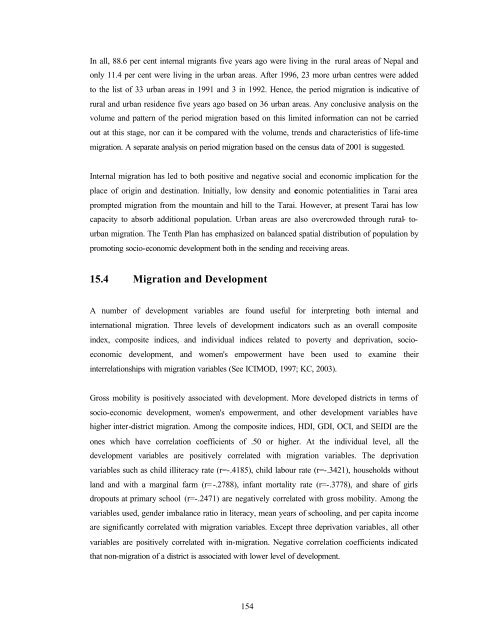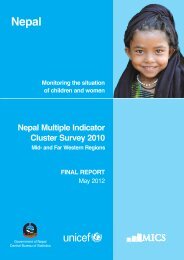Chapter 15 Internal Migration in Nepal - Central Bureau of Statistics
Chapter 15 Internal Migration in Nepal - Central Bureau of Statistics
Chapter 15 Internal Migration in Nepal - Central Bureau of Statistics
Create successful ePaper yourself
Turn your PDF publications into a flip-book with our unique Google optimized e-Paper software.
In all, 88.6 per cent <strong>in</strong>ternal migrants five years ago were liv<strong>in</strong>g <strong>in</strong> the rural areas <strong>of</strong> <strong>Nepal</strong> and<br />
only 11.4 per cent were liv<strong>in</strong>g <strong>in</strong> the urban areas. After 1996, 23 more urban centres were added<br />
to the list <strong>of</strong> 33 urban areas <strong>in</strong> 1991 and 3 <strong>in</strong> 1992. Hence, the period migration is <strong>in</strong>dicative <strong>of</strong><br />
rural and urban residence five years ago based on 36 urban areas. Any conclusive analysis on the<br />
volume and pattern <strong>of</strong> the period migration based on this limited <strong>in</strong>formation can not be carried<br />
out at this stage, nor can it be compared with the volume, trends and characteristics <strong>of</strong> life-time<br />
migration. A separate analysis on period migration based on the census data <strong>of</strong> 2001 is suggested.<br />
<strong>Internal</strong> migration has led to both positive and negative social and economic implication for the<br />
place <strong>of</strong> orig<strong>in</strong> and dest<strong>in</strong>ation. Initially, low density and economic potentialities <strong>in</strong> Tarai area<br />
prompted migration from the mounta<strong>in</strong> and hill to the Tarai. However, at present Tarai has low<br />
capacity to absorb additional population. Urban areas are also overcrowded through rural- tourban<br />
migration. The Tenth Plan has emphasized on balanced spatial distribution <strong>of</strong> population by<br />
promot<strong>in</strong>g socio-economic development both <strong>in</strong> the send<strong>in</strong>g and receiv<strong>in</strong>g areas.<br />
<strong>15</strong>.4 <strong>Migration</strong> and Development<br />
A number <strong>of</strong> development variables are found useful for <strong>in</strong>terpret<strong>in</strong>g both <strong>in</strong>ternal and<br />
<strong>in</strong>ternational migration. Three levels <strong>of</strong> development <strong>in</strong>dicators such as an overall composite<br />
<strong>in</strong>dex, composite <strong>in</strong>dices, and <strong>in</strong>dividual <strong>in</strong>dices related to poverty and deprivation, socioeconomic<br />
development, and women's empowerment have been used to exam<strong>in</strong>e their<br />
<strong>in</strong>terrelationships with migration variables (See ICIMOD, 1997; KC, 2003).<br />
Gross mobility is positively associated with development. More developed districts <strong>in</strong> terms <strong>of</strong><br />
socio-economic development, women's empowerment, and other development variables have<br />
higher <strong>in</strong>ter-district migration. Among the composite <strong>in</strong>dices, HDI, GDI, OCI, and SEIDI are the<br />
ones which have correlation coefficients <strong>of</strong> .50 or higher. At the <strong>in</strong>dividual level, all the<br />
development variables are positively correlated with migration variables. The deprivation<br />
variables such as child illiteracy rate (r=-.4185), child labour rate (r=-.3421), households without<br />
land and with a marg<strong>in</strong>al farm (r= -.2788), <strong>in</strong>fant mortality rate (r=-.3778), and share <strong>of</strong> girls<br />
dropouts at primary school (r=-.2471) are negatively correlated with gross mobility. Among the<br />
variables used, gender imbalance ratio <strong>in</strong> literacy, mean years <strong>of</strong> school<strong>in</strong>g, and per capita <strong>in</strong>come<br />
are significantly correlated with migration variables. Except three deprivation variables, all other<br />
variables are positively correlated with <strong>in</strong>-migration. Negative correlation coefficients <strong>in</strong>dicated<br />
that non-migration <strong>of</strong> a district is associated with lower level <strong>of</strong> development.<br />
<strong>15</strong>4
















